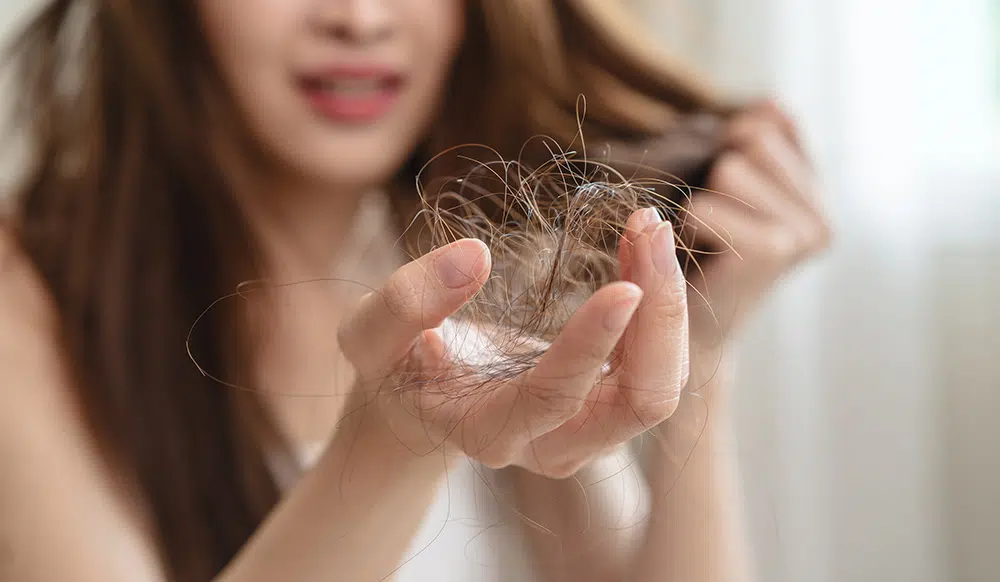Are you noticing unexpected hair shedding alongside your fibromyalgia symptoms? Fibromyalgia and hair loss are more connected than you might think. Chronic pain, stress, and nutrient imbalances can disrupt your hair growth cycle, leading to thinning strands and scalp sensitivity.
This guide will help you understand why it happens, how long it lasts, and what you can do to restore your hair. With expert tips, recovery timelines, and supportive strategies, you’ll learn how to take charge of both your health and your hair.
Can Fibromyalgia Lead to Hair Loss?

Yes, fibromyalgia can lead to temporary hair loss, most commonly through a condition called telogen effluvium. This type of hair shedding happens when the body experiences physical or emotional stress, pushing hair follicles prematurely into the shedding phase of their growth cycle.
People with fibromyalgia often endure:
- Persistent pain and fatigue
- Psychological stress
- Poor sleep and hormonal imbalance
All of these can trigger or worsen hair shedding episodes.
Temporary vs. Permanent Hair Loss
- Telogen effluvium is typically temporary and reversible within 3 to 6 months.
- Fibromyalgia-related hair loss is rarely permanent unless compounded by other conditions like thyroid disease or alopecia areata.
Who’s Most at Risk?
- Patients with frequent flare-ups
- Those under chronic stress or with poor nutrient absorption
- Individuals on certain medications (e.g., antidepressants, anticonvulsants)
2. Behind the Loss: Scalp Pain, Allodynia & Telogen Effluvium
Scalp allodynia—a type of skin sensitivity where even brushing hair feels painful—is common in fibromyalgia. This heightened nerve response, combined with inflammation and muscle tension, can make managing your hair extremely uncomfortable.
What is Telogen Effluvium?
- A sudden shift of hair follicles into the “resting” phase
- Triggered by systemic stress, illness, or nutritional issues
- Results in diffuse thinning, not patchy loss
Most hair regrows once the trigger is managed, but it can take several months for visible improvement.
Expert Insight: According to dermatologists, regrowth usually begins 3–4 months after the stressor resolves. However, if triggers persist (like ongoing fibromyalgia flare-ups), regrowth may be delayed.
Nutritional & Hormonal Factors to Watch
People with fibromyalgia often experience malabsorption or dietary limitations, increasing the risk of nutrient deficiencies that impact hair health.
Iron/Ferritin Deficiency
- Low ferritin (stored iron) levels are linked with hair thinning, even if hemoglobin is normal.
- Aim for ferritin levels above 70 ng/mL for optimal hair regrowth.
Vitamin B12 and D
- Low vitamin B12 affects oxygen transport to hair follicles.
- Vitamin D deficiency is common in fibromyalgia and disrupts immune regulation, possibly contributing to hair shedding.
Thyroid Dysfunction
- Hypothyroidism (underactive thyroid) often mimics fibromyalgia symptoms and causes hair loss.
- A full thyroid panel (TSH, Free T3, Free T4) is essential if hair loss persists.
Co-Occurring Conditions That Can Worsen Hair Health
Several conditions commonly found alongside fibromyalgia can aggravate hair thinning:
- Thyroid Disorders
- Alopecia Areata (autoimmune patchy hair loss)
- Polycystic Ovary Syndrome (PCOS)
- Lupus or other autoimmune diseases
Checklist: What to Discuss With Your Doctor
- Have your iron, B12, vitamin D, and thyroid levels been tested?
- Have any new medications coincided with your hair loss?
- Are there autoimmune symptoms like skin rashes, joint swelling, or fatigue?
Lifestyle & Hair Care: Smart Strategies
Fibromyalgia can make even the simplest routines feel overwhelming. Here are practical, gentle strategies for minimizing hair loss while supporting regrowth.
Stress Management
- Practice mindfulness meditation, CBT (Cognitive Behavioral Therapy), or hydrotherapy
- Reduce daily stressors and maintain sleep hygiene
Scalp & Styling Tips
- Avoid tight hairstyles or harsh brushes
- Limit heat styling and heavy products
- Use wide-tooth combs and scalp-soothing shampoos
Nutritional Support
- Include protein, iron-rich foods, omega-3s, and anti-inflammatory herbs
- Consider hair-focused supplements with biotin, zinc, and vitamin D (under medical supervision)
Recovery Timeline
| Month | What’s Happening? | Visible Progress? |
|---|---|---|
| 0–2 | Hair shedding intensifies | Minimal regrowth |
| 3–4 | Hair enters early regrowth phase | New hairs may appear (fine) |
| 5–6 | Visible thickening begins | Confidence improves |
| 7–9 | Regrowth stabilizes | Hair enters the early regrowth phase |
When to See a Specialist
If your hair loss lasts longer than 6 months, worsens, or is accompanied by other symptoms like fatigue, swelling, or hormonal changes, consult with:
- A rheumatologist for fibromyalgia management
- A dermatologist for scalp and hair conditions
- An endocrinologist for thyroid and hormonal testing

Tests to Request
- CBC (Complete Blood Count)
- Ferritin, B12, Vitamin D
- TSH, Free T3, Free T4
- ANA (if autoimmune disease suspected)
Frequently Asked Questions (FAQ)
Is hair loss from fibromyalgia permanent?
No. In most cases, hair regrows once triggers like stress or nutritional issues are addressed.
Can fibromyalgia medications cause hair loss?
Some medications—like antidepressants and anticonvulsants—may contribute. Speak to your doctor if you notice a correlation
How fast will my hair grow back?
Regrowth often starts within 3–4 months, but full restoration may take 6–9 months.
What hair products are safe for sensitive scalps?
Look for fragrance-free, hypoallergenic, and pH-balanced formulas. Avoid sulfates and parabens.
Final Thoughts
Struggling with unexplained hair loss alongside chronic pain? It may be more than a coincidence. Book a consultation with Dr. Rana Irfan in Islamabad to receive personalized assessment, nutritional testing, and hair restoration guidance tailored for fibromyalgia patients.
